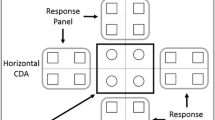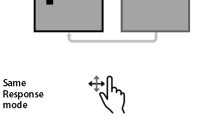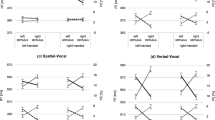Abstract
In two-choice tasks for which stimuli and responses vary along orthogonal dimensions, one stimulus-response map** typically yields better performance than another. For unimanual movement responses, the hand used to respond, hand posture (prone or supine), and response eccentricity influence this orthogonal stimulus-response compatibility (SRC) effect. All accounts of these phenomena attribute them to response-related processes. Two experiments examined whether manipulation of stimulus-set position along the dimension on which the stimuli varied influences orthogonal SRC in a manner similar to the way that response location does. The experiments differed in whether the stimulus dimension was vertical and the response dimension horizontal, or vice versa. In both experiments, an advantage of map** up with right and down with left was evident for several response modes, and stimulus-set position had no influence on the orthogonal SRC effect. The lack of effect of stimulus-set position is in agreement with the emphasis that present accounts place on response-related processes. We favor a multiple asymmetric codes account, for which the present findings imply that the polarity of stimulus codes does not vary across task contexts although the polarity of response codes does.
Similar content being viewed by others
References
Adam, J. J., Boon, B., Paas, F. G. W. C., & Umiltà, C. (1998). The up-right/down-left advantage for vertically oriented stimuli and horizontally oriented responses: A dual-strategy hypothesis. Journal of Experimental Psychology: Human Perception and Performance, 24, 1582–1595.
Bauer, D. W., & Miller, J. (1982). Stimulus-response compatibility and the motor system. Quarterly Journal of Experimental Psychology, 34A, 367–380.
Cho, Y. S., & Proctor, R. W. (2001). Effect of an initiating action on the up-right/down-left advantage for vertically arrayed stimuli and horizontally arrayed responses. Journal of Experimental Psychology: Human Perception and Performance, 27, 472–484.
Cho, Y. S., & Proctor, R. W. (2002). Influences of hand posture and hand position on compatibility effects for up-down stimuli mapped to left-right responses: Evidence for a hand-referent hypothesis. Perception & Psychophysics, 64, 1301–1315.
Cho, Y. S., & Proctor, R. W. (2003a). Stimulus and response representations underlying orthogonal stimulus-response compatibility effects. Psychonomic Bulletin & Review, 10, 45–73.
Cho, Y. S., & Proctor, R. W. (2003b). Representing response position relative to display location: Influence on orthogonal stimulus-response compatibility. Manuscript submitted for publication.
Clark, H. H. (1973). Space, time, semantics and the child. In T. E. Moore (Ed.), Cognitive development and the acquisition of language (pp. 27–63). New York: Academic Press.
Hommel, B., & Prinz, W. (Eds.) (1997). Theoretical issues in stimulus-response compatibility. Amsterdam: North-Holland.
Lippa, Y. (1996). A referential-coding explanation for compatibility effects of physically orthogonal stimulus and response dimensions. Quarterly Journal of Experimental Psychology, 49A, 950–971.
Lippa, Y., & Adam, J. J. (2001). Orthogonal stimulus-response compatibility resulting from spatial transformations. Perception & Psychophysics, 63, 156–174.
Lu C.-H., & Proctor, R. W. (1995). The influence of irrelevant location information on performance: A review of the Simon and spatial Stroop effects. Psychonomic Bulletin & Review, 2, 174–207.
Michaels, C. F. (1989). S-R compatibilities depend on eccentricity of responding hand. Quarterly Journal of Experimental Psychology, 41A, 262–272.
Michaels, C. F., & Schilder, S. (1991). Stimulus-response compatibilities between vertically oriented stimuli and horizontally oriented responses: The effects of hand position and posture. Perception & Psychophysics, 49, 342–248.
Olson, G. M., & Laxar, K. (1973). Asymmetries in processing the terms “right” and “left”. Journal of Experimental Psychology, 100, 284–290.
Olson, G. M., & Laxar, K. (1974). Processing the terms right and left: A note on left-handers. Journal of Experimental Psychology, 102, 1135–1137.
Proctor, R. W., & Cho, Y. S. (2001). The up-right/down-left advantage occurs for both participant-paced and computer-paced conditions: An observation on Adam, Boon, Paas, & Umiltà (1998). Journal of Experimental Psychology: Human Perception and Performance, 27, 466–471.
Proctor, R. W., & Cho, Y. S. (2003). Effects of relative position and response eccentricity on orthogonal stimulus-response compatibility with joystick and keypress responses. Quarterly Journal of Experimental Psychology, 56A, 309–327.
Proctor, R. W., & Reeve, T. G. (Eds.) (1990). Stimulus-response compatibility: An integrated Perspective. Amsterdam: North-Holland.
Proctor, R. W., Wang, H., & Vu, K.-P. L. (2002). Influences of different combinations of conceptual, perceptual, and structural similarity on stimulus-response compatibility. Quarterly Journal of Experimental Psychology, 55A, 59–74.
Umiltà, C. (1991). Problems of the salient-feature coding hypothesis: Comment on Weeks and Proctor. Journal of Experimental Psychology: General, 120, 83–86.
Vu, K.-P. L., Proctor, R. W., & Pick, D. F. (2000). Vertical versus horizontal spatial incompatibility: Right-left prevalence with bimanual responses. Psychological Research, 64, 25–40.
Weeks, D. J., & Proctor, R. W. (1990). Salient-features coding in the translation between orthogonal stimulus-response dimensions. Journal of Experimental Psychology: General, 119, 355–366.
Weeks, D. J., & Proctor, R. W. (1991). Salient-features coding and orthogonal compatibility effects: A reply to Umiltà. Journal of Experimental Psychology: General, 120, 87–89.
Weeks, D. J., Proctor, R. W., & Beyak, B. (1995). Stimulus-response compatibility for vertically oriented stimuli and horizontally oriented responses: Evidence for spatial coding. Quarterly Journal of Experimental Psychology, 48A, 367–383.
Acknowledgements
We thank Yvonne Lippa, Thomas Kleinsorge, Carolo Umiltà, and an anonymous reviewer for helpful comments on a previous version of the paper.
Author information
Authors and Affiliations
Corresponding author
Rights and permissions
About this article
Cite this article
Cho, Y.S., Proctor, R.W. Stimulus-set location does not affect orthogonal stimulus-response compatibility. Psychological Research 69, 106–114 (2004). https://doi.org/10.1007/s00426-003-0158-1
Received:
Accepted:
Published:
Issue Date:
DOI: https://doi.org/10.1007/s00426-003-0158-1




